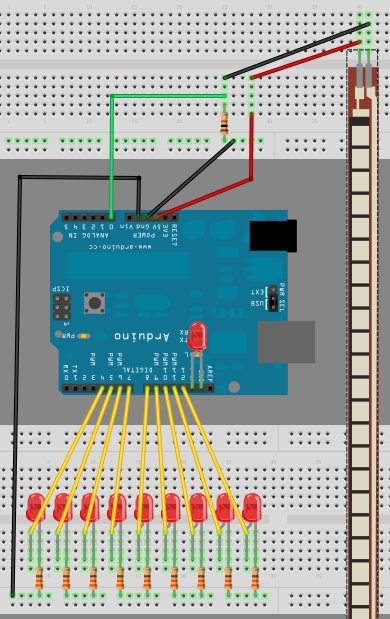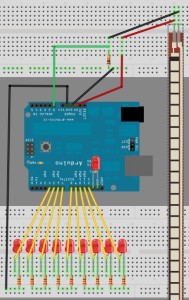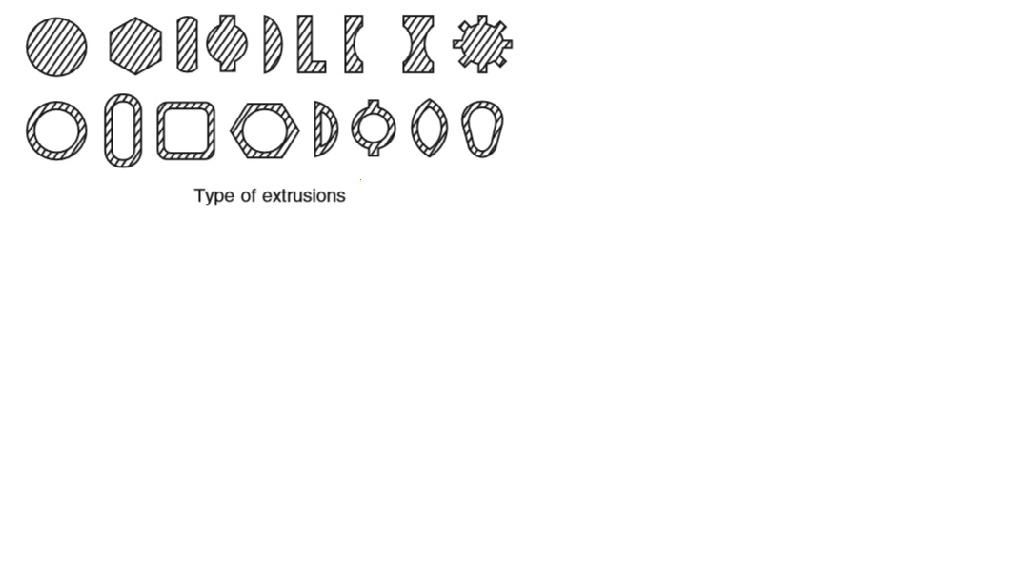Arduino UNO: Flex Sensor and LEDs
Using the same LED matrix as before, and swapping the Photo Resistor for a Flex (or Bend) sensor, and a slight modification to the code, I can now have a light show that can be controlled by “Bending”.
I used my finger to bend the sensor, but I could have attached it to a plant, a tree or anything else that bends. The bending changes the resistance, and therefore the INPUT value at analog pin 0.
The parts required
- Arduino UNO
- 10 x Red LEDs
- 9 x 330 Ohm resistors for the LEDs
- 1 x 10K Ohm resistors for the flex sensor.
- 1 x Flex sensor
- Wires and Breadboard to connect it all together
The Sketch
The Arduino Code:
//Flex Sensor Pin (flexPin)
//the analog pin the Flex Sensor is connected to
int flexPin = 0;
void setup() {
for (int i=4; i<14; i++){
pinMode(i, OUTPUT); //sets the led pins 4 to 13 to output
}
}
void loop(){
//Ensure to turn off ALL LEDs before continuing
for (int i=4; i<14; i++){
digitalWrite(i, LOW);
}
/* Read the flex Level
Adjust the value 130 to 275 to span 4 to 13
The values 130 and 275 may need to be widened to suit
the minimum and maximum flex levels being read by the
Analog pin */
int flexReading = map(analogRead(flexPin), 130, 275, 4, 13);
// Make sure the value does not go beyond 4 or 13
int LEDnum = constrain(flexReading, 4, 13);
/*Call the blink function: this will turn the LED on for 10 milliseconds, and keep it
off for only 1 millisecond. You can change the blink rate by changing these values,
however, I want a quick response time when the flex sensor bends, hence the small
values. LEDnum determines which LED gets turned on.*/
blink(LEDnum, 10,1);
}
// The blink function - used to turn the LEDs on and off
void blink(int LEDPin, int onTime, int offTime){
// Turn the LED on
digitalWrite(LEDPin, HIGH);
// Delay so that you can see the LED go On.
delay(onTime);
// Turn the LED Off
digitalWrite(LEDPin, LOW);
// Increase this Delay if you want to see an actual blinking effect.
delay(offTime);
}













Post Comment
You must be logged in to post a comment.